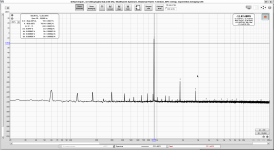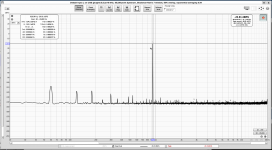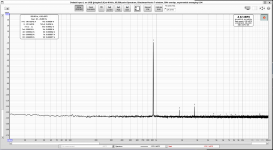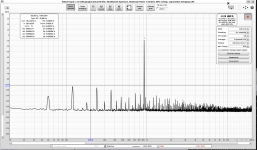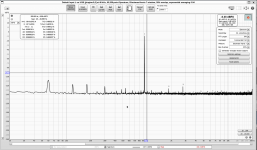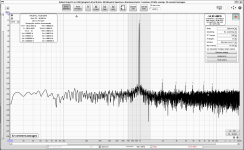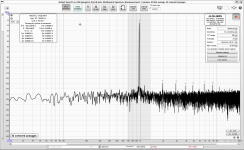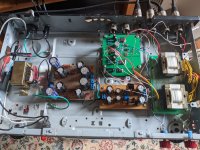Yes, transformers are source of 60 Hz stray magnetic fields. Despite divider steel plate, something will leak through.Is it possible the transformers or the 7815/7915 board are the source of the EMI?
Any shielded cable will be an improvement. Ground and signal carried by core wires and shield connected to ground at one end is good option.I have some small two-core shielded cable here (although I can't remember why I bought it) so I could use that with the signal and ground carried by the core, and ground the shield at one end (presumably).
Microphone input is too sensitive. Use line input instead, with RCA/6.3 mm mono adapter.I'm using single-core coax connected to an XLR, and the microphone input on the Focusrite.
I've been fiddling with my testing setup, to try to eliminate operator error and misunderstandings about REW before altering things in the preamp. I've found one interesting thing. I stream music to my DAC from the internal SSD in a fanless computer, which sits on the same rack as the preamp and the Focusrite I'm using. (To be clear, this is entirely separate from the laptop I'm using for REW.) The first two plots below show the exact same test setup, the first with the SMPS for this computer unplugged, and the second with it plugged in. It makes no difference if this computer is booted up or not, so it looks like either the preamp or my test setup is picking up EMI from the SMPS brick. The interconnects I'm using to connect to the Focusrite don't seem to be the problem (since using them to measure loopback with or without the SMPS doesn't show the same behavior) so somehow the wiring inside the preamp seems to be picking up the EMI from the SMPS. (It certainly isn't coming by any electrical or USB connection, since these are all disconnected.) Interesting. I wouldn't have thought this possible, since the preamp is in a steel case and the SMPS isn't so very close to it, anyhow, but there it is. Hopefully screened signal wiring will eliminate this.
One thing I don't understand; I'd be grateful for an explanation. If I set the volume of the preamp so that my DMM measures the same AC voltage at the output of the preamp as at the output of the Focusrite (0.43V) then REW shows the signal at -20.9dBFS, compared to -8.9 for the loopback. I also compared with my diy Iron Pre, which gave -11.6dBFS for 0.43V. The third, fourth and fifth plots who loopback, Tombo's preamp and the Iron Pre. What causes the difference? Is it an impedance issue or something? Should I take off the 47k load I put in? I'm clearly missing something, or doing something wrong.
One thing I don't understand; I'd be grateful for an explanation. If I set the volume of the preamp so that my DMM measures the same AC voltage at the output of the preamp as at the output of the Focusrite (0.43V) then REW shows the signal at -20.9dBFS, compared to -8.9 for the loopback. I also compared with my diy Iron Pre, which gave -11.6dBFS for 0.43V. The third, fourth and fifth plots who loopback, Tombo's preamp and the Iron Pre. What causes the difference? Is it an impedance issue or something? Should I take off the 47k load I put in? I'm clearly missing something, or doing something wrong.
Attachments
SMPS supplies are nasty devices as they produce EM pulses that propagate through space and also inject noise to power network. Focusrite is not connected to power supply that has direct path to mains. Preamplifier chassis is connected to the safety earth (power earth) and that is also a path where some noise enters circuit. You have Schurter RF filter at input and that is excellent. That filter has large effect at 100 kHz and up, but very little around 1 kHz.
Another point is that noise looks large as Focusrite + REW can measure less than 1 uV. Noise on your measurements is probably about 10 uV range, if signal is 0.43 V.
First and second measurements are actually almost the same. It is just different scale that makes peaks look larger. On first picture, bottom is at -240 dB. On second, it is -190 dB. That makes for a 50 dB difference.
As for different levels, load resistor doesn’t matter if not very low in value, like 33 Ω. That could make difference, but 47 K can’t.
dBFS is relative uncalibrated scale. Signal peak depends on Focusrite input gain knob position. Was it always at the same position?
Another point is that noise looks large as Focusrite + REW can measure less than 1 uV. Noise on your measurements is probably about 10 uV range, if signal is 0.43 V.
First and second measurements are actually almost the same. It is just different scale that makes peaks look larger. On first picture, bottom is at -240 dB. On second, it is -190 dB. That makes for a 50 dB difference.
As for different levels, load resistor doesn’t matter if not very low in value, like 33 Ω. That could make difference, but 47 K can’t.
dBFS is relative uncalibrated scale. Signal peak depends on Focusrite input gain knob position. Was it always at the same position?
Hi Tombo,
Incidentally, this shows while using REW; without stopping RTA, plugging or unplugging the SMPS and resetting the averaging makes the forest appear or disappear.
Noted.SMPS supplies are nasty devices as they produce EM pulses that propagate through space and also inject noise to power network. Focusrite is not connected to power supply that has direct path to mains. Preamplifier chassis is connected to the safety earth (power earth) and that is also a path where some noise enters circuit. You have Schurter RF filter at input and that is excellent. That filter has large effect at 100 kHz and up, but very little around 1 kHz.
I realise all this is very low level, and well below anything likely to be audible. Nonetheless it is there, and I'd like to reduce or eliminate it if it can be done easily. Besides, your first post describes this as part of your OCD log, right? 🙂Another point is that noise looks large as Focusrite + REW can measure less than 1 uV. Noise on your measurements is probably about 10 uV range, if signal is 0.43 V.
The different scales are due to having to repeat one of the plots, after accidentally deleting the screenshot. And yes they're almost the same, but not quite. Signal is at -9.08dB in one case, 9.09 in the other. The graph bottoms out in both cases at around -140dB. 60Hz peak is very similar also, at about -110dB. The differences are the peaks at 120Hz and 240Hz, which jump around 20 or 30 dB, but particularly all the hash between 1kHz and 8kHz; when the SMPS is unplugged the second and third harminc peaks stand out; when it is plugged in they are buried in the forest... Again, nothing plausibly audible, but it's there, and I find it interesting to see the influence of the SMPS so clearly.First and second measurements are actually almost the same. It is just different scale that makes peaks look larger. On first picture, bottom is at -240 dB. On second, it is -190 dB. That makes for a 50 dB difference.
Incidentally, this shows while using REW; without stopping RTA, plugging or unplugging the SMPS and resetting the averaging makes the forest appear or disappear.
OK, thanks.As for different levels, load resistor doesn’t matter if not very low in value, like 33 Ω. That could make difference, but 47 K can’t.
Yes. I didn't change the Focusrite at all. I'm going to look into this again over the weekend.dBFS is relative uncalibrated scale. Signal peak depends on Focusrite input gain knob position. Was it always at the same position?
I find it interesting to see the influence of the SMPS so clearly.
Someone well said that 20 years ago, for a level of measurement performance we get from 110$ Focusrite and free software, you should take a mortgage on your house.
So, yes. It is fascinating how easy can we measure so low signal values. If possible, try to plug SMPS in different power socket. If that another socket is on another power phase, there will be no direct noise path through common power supply wire.
BTW, at line input medium gain, Focusrite has noise level about -138 dBV. That allows for measuring reliably signal at level of only 0.2 uV.
If possible, try to plug SMPS in different power socket. If that another socket is on another power phase, there will be no direct noise path through common power supply wire.
I did this on Friday, and it had the same effect. However today I've been trying to repeat the whole test today, and the effect seems smaller, if there at all. I can't be certain I'm using precisely the same settings on the Focusrite and REW, but nonetheless I suspect there was perhaps a dodgy connection on my test setup that was somehow picking up the EMI, and not the internals in the preamp. I'll keep at it.
BTW, at line input medium gain, Focusrite has noise level about -138 dBV. That allows for measuring reliably signal at level of only 0.2 uV.
Awesome.
BTW, I can't get anywhere near the same noise levels using the line input as I do with the mic input, and neither produce loopback results as good as your test results on the buffer in the first post. Could you describe your testing setup a little? Are you using the Focusrite internal generator? And could you be more precise about what "0.4V rms into transformer" means? Sorry if this should be obvious, but it would help in locating operator error on my part.
And if all this REW stuff is getting too OT please say so; I don't want to take the focus of the thread too far from your buffer.
Distortion measurement at first post was made using ‘coherent’ averaging distortion setting at distortion settings control panel. That option pushes noise level down by some 10 - 15 dB and enables measurement of very low distortion. So, this is not realistic measurement for hum and noise, but for distortion only.
0.4 V into transformer meant that buffer was driving actual Cinemag transformer with 0.4 V rms at its output. Such low voltage was used as that was point where Focurite signal generator was able to give lowest distortion of about 0.0001%. Usual minimum is about 0.0003%
For me, minimum even depends on used laptop and often I can’t go down past 0.0006%.
Here you can find first buffer measurements as a headphone amplifier, with some 50 Hz noise and distortion:
https://www.diyaudio.com/community/...a828-lme49600-combination.364756/post-6917293
Try line input with setting signal generator to 0 dBFS, line input gain knob to 11 o’clock and monitor knob (generator output) to 1 o’clock.
0.4 V into transformer meant that buffer was driving actual Cinemag transformer with 0.4 V rms at its output. Such low voltage was used as that was point where Focurite signal generator was able to give lowest distortion of about 0.0001%. Usual minimum is about 0.0003%
For me, minimum even depends on used laptop and often I can’t go down past 0.0006%.
Here you can find first buffer measurements as a headphone amplifier, with some 50 Hz noise and distortion:
https://www.diyaudio.com/community/...a828-lme49600-combination.364756/post-6917293
Try line input with setting signal generator to 0 dBFS, line input gain knob to 11 o’clock and monitor knob (generator output) to 1 o’clock.
Thanks. I'll try that as soon as I can, although there will be a bit of a delay. I use REW on a gentoo linux system, and it's a bit clunky, at least with my configuration. I'm looking it al over and reinstalling, in the hopes of stopping it changing preferences without my asking it to. (Like the 124kV business. Keeps resetting to that for some reason.)
I’ve checked again how to get lowest possible loopback distortion and here are the settings. ‘Lock frequency to RTA FFT’ signal generator setting is very important. Position of gain and monitor knobs should be about 11 o’clock for line-in gain and 1 o’clock for monitor. Distortion will be around 0.0001%, occasionally dropping to 0.00008%. At those settings, measured signal generator output was 0.775 V or 0 dBU. Changing gain or monitor levels, brings distortion to usual 0.0003% or worse.

that's realm for you, younger ones
we Old Farts are content with 0.1% starting THD
(mainly because we don't know how to get lower THD of amp itself, anyway)

we Old Farts are content with 0.1% starting THD
(mainly because we don't know how to get lower THD of amp itself, anyway)

Younger one? Moi? 🤣
Thank you. 🙂
Isn't the blessing of elephants farts to be blamed for this?
Thank you. 🙂
we Old Farts are content with 0.1% starting THD

Isn't the blessing of elephants farts to be blamed for this?
Tombo: Thanks for the detailed info. I've tried to put all data in as similarly as I can to your did (-3dFBS on the generator, ~11 o'clock for gain, ~1 o'clock for monitor and so on), using the line input. I can't get the distortion or noise as low as you did, with or without coherent averaging, but I can get THD to about 0.0003% - 0.0004%, which is close to the Focusrite specs. I may have to be content with that, and in any event it is certainly good enough for practical purposes
I found out some more interesting stuff. It turns out that the noise and distortion (mostly the small peaks at 60Hz and multiples) depend critically on where the Focusrite is in the room. In all the plots I'm measuring loopback, with the Focusrite connected to a laptop running on battery, and not connected to anything else. REW was left running with all settings the same, and I moved the Focusrite (but not the laptop) first next to the stereo to about 8ft away, near the laptop.
The first two plots show what happens with everything in the room turned on (three lamps, a TV, a copmuter monitor, laptop SMPS, all the stereo...), first with the Focusrite near the laptop and then with it near the stereo. Peaks appear at 60Hz and multiples thereof. The next two plots show what happens with everything turned off (laptop on battery, me stumbling around in the dark... ) again first with the Focusrite near the laptop and then near the stereo. No peaks appear. I also tested what happens with the stereo on (streamer, DAC, preamp, and two F5 monoblocks) and everything else off; with the Focusrite next to the stereo I got the fifth plot, which is much better than the second, although worse than the first. (Near the laptop it looked just like the first and third plots.) I also checked what happens with just the SMPS for the streamer and the rest of the stereo off; it looked just like the fifth plot. The last plot (which I find the most interesting) shows what happens with the stereo off (and unplugged) and everything else on, measured with the Focsurite near the stereo; it looks almost the same as the second plot.
So. The Focusrite (or the interconnect running from front to back on it) is picking up interference. It is worse the closer it is to the stereo, better the farther away it is from the stereo. It does not depend much on whether the stereo is on or not, but depends more on the other SMPSs in the room, and hardly at all on the F5 monoblocks.
This is all very low level, of course, but fascinating just the same. It seems the position of the Focusrite affects things more than I would have thought.
I found out some more interesting stuff. It turns out that the noise and distortion (mostly the small peaks at 60Hz and multiples) depend critically on where the Focusrite is in the room. In all the plots I'm measuring loopback, with the Focusrite connected to a laptop running on battery, and not connected to anything else. REW was left running with all settings the same, and I moved the Focusrite (but not the laptop) first next to the stereo to about 8ft away, near the laptop.
The first two plots show what happens with everything in the room turned on (three lamps, a TV, a copmuter monitor, laptop SMPS, all the stereo...), first with the Focusrite near the laptop and then with it near the stereo. Peaks appear at 60Hz and multiples thereof. The next two plots show what happens with everything turned off (laptop on battery, me stumbling around in the dark... ) again first with the Focusrite near the laptop and then near the stereo. No peaks appear. I also tested what happens with the stereo on (streamer, DAC, preamp, and two F5 monoblocks) and everything else off; with the Focusrite next to the stereo I got the fifth plot, which is much better than the second, although worse than the first. (Near the laptop it looked just like the first and third plots.) I also checked what happens with just the SMPS for the streamer and the rest of the stereo off; it looked just like the fifth plot. The last plot (which I find the most interesting) shows what happens with the stereo off (and unplugged) and everything else on, measured with the Focsurite near the stereo; it looks almost the same as the second plot.
So. The Focusrite (or the interconnect running from front to back on it) is picking up interference. It is worse the closer it is to the stereo, better the farther away it is from the stereo. It does not depend much on whether the stereo is on or not, but depends more on the other SMPSs in the room, and hardly at all on the F5 monoblocks.
This is all very low level, of course, but fascinating just the same. It seems the position of the Focusrite affects things more than I would have thought.
Attachments
-
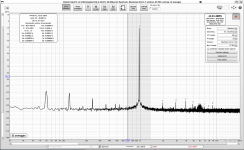 All_on_except_stereo_frite_by_stereo.png61.8 KB · Views: 84
All_on_except_stereo_frite_by_stereo.png61.8 KB · Views: 84 -
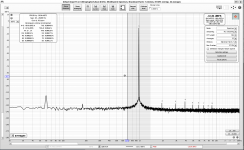 Stereo_on_frite_by_stereo.png61.8 KB · Views: 82
Stereo_on_frite_by_stereo.png61.8 KB · Views: 82 -
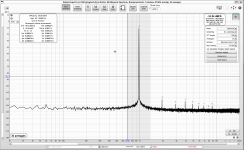 All_off_frite_by_stereo.png61.1 KB · Views: 85
All_off_frite_by_stereo.png61.1 KB · Views: 85 -
 All_off_frite_by_laptop.png60.8 KB · Views: 73
All_off_frite_by_laptop.png60.8 KB · Views: 73 -
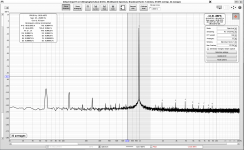 All_on_frite_by_stereo.png62.7 KB · Views: 75
All_on_frite_by_stereo.png62.7 KB · Views: 75 -
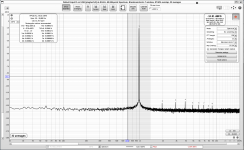 All_on_frite_by_laptop.png60.9 KB · Views: 82
All_on_frite_by_laptop.png60.9 KB · Views: 82
I ran the tests again today.
1. The odd behavior from the voltage output of the preamp that I referred to on Friday in post #182 is not repeatable. Must have been operator error of some kind. So sanity returns...
2. I have confirmed precisely the same behavior I found yesterday, both with regard to the position of the Focusrite and the effect of turning other electrics in the room on and off. In fact, if I go round the room plugging and unplugging things I can see the dBFS value of the 60Hz peak move up and down. Pretty cool. Of course as I observed before, it's all very low level; just the stereo on or everything on varies the peak from -120dB to -110dB. This is just through the air, mind you, no electrical connection. Also, I used "incoherent" averaging (if I can call it that); coherent averaging doesn't show the same thing, which backs up what Tombo was saying about coherent averaging being more appropriate for THD measurements than noise.
3. Finally, I measured the preamp again, in the most favorable of measurement situations (everything in the middle of the room, everything except the preamp turned off, coherent averaging). Here are the loopback plot and the preamp output, which to my eyes are indistinguishable. Once I've cleaned up the internals it should measure just as well with other things plugged in.
Tombo: Thanks again for this brilliant buffer. Not to mention your patience with my almost-OT ramblings about REW.
1. The odd behavior from the voltage output of the preamp that I referred to on Friday in post #182 is not repeatable. Must have been operator error of some kind. So sanity returns...
2. I have confirmed precisely the same behavior I found yesterday, both with regard to the position of the Focusrite and the effect of turning other electrics in the room on and off. In fact, if I go round the room plugging and unplugging things I can see the dBFS value of the 60Hz peak move up and down. Pretty cool. Of course as I observed before, it's all very low level; just the stereo on or everything on varies the peak from -120dB to -110dB. This is just through the air, mind you, no electrical connection. Also, I used "incoherent" averaging (if I can call it that); coherent averaging doesn't show the same thing, which backs up what Tombo was saying about coherent averaging being more appropriate for THD measurements than noise.
3. Finally, I measured the preamp again, in the most favorable of measurement situations (everything in the middle of the room, everything except the preamp turned off, coherent averaging). Here are the loopback plot and the preamp output, which to my eyes are indistinguishable. Once I've cleaned up the internals it should measure just as well with other things plugged in.
Tombo: Thanks again for this brilliant buffer. Not to mention your patience with my almost-OT ramblings about REW.
Attachments

Great. Now you can reliably compare your results with other measurements.
Hopefully, this all will help someone else.
Hopefully so. Although I may have let the thread drift OT; sorry! I also hope more people will try this buffer out; it sounds great. I've done another pair to try as input buffer on a power amp; maybe my M2s, maybe something else. But that will have to wait.
Hi Tombo,
I'm still enjoying the preamp I built with the buffers; it's not quite in final form yet, but I'm getting there slowly, when not distracted by other things.
Meanwhile, I've been having some fun experimenting with output transformers (Edcor XS4400) configured to give an eight-step AVC. I'm keeping the input pot for the moment although intend to keep it at "full volume" or close to it, by adjusting the output on the AVC. I've discussed this on Zen Mod's thread, and have now put a pair of your buffers in to try. I'm speculating about altering (actually, reducing) the gain on the boards, since I think this will move the "normal" listening position on the AVC to a more interesting spot. I know that gain is 1+R12/R11, and that on one of the schematics you suggest a range of 100R to 3k3, but I am curious as to whether 100R is a lower limit for any technical reason? I'm curious to try as close to unity gain as is realistic with breaking something or other. Certainly 100R is worth trying, but I'd go lower if there are no reasons not to give it a go.
I'm still enjoying the preamp I built with the buffers; it's not quite in final form yet, but I'm getting there slowly, when not distracted by other things.
Meanwhile, I've been having some fun experimenting with output transformers (Edcor XS4400) configured to give an eight-step AVC. I'm keeping the input pot for the moment although intend to keep it at "full volume" or close to it, by adjusting the output on the AVC. I've discussed this on Zen Mod's thread, and have now put a pair of your buffers in to try. I'm speculating about altering (actually, reducing) the gain on the boards, since I think this will move the "normal" listening position on the AVC to a more interesting spot. I know that gain is 1+R12/R11, and that on one of the schematics you suggest a range of 100R to 3k3, but I am curious as to whether 100R is a lower limit for any technical reason? I'm curious to try as close to unity gain as is realistic with breaking something or other. Certainly 100R is worth trying, but I'd go lower if there are no reasons not to give it a go.
Incidentally, ont hese two new buffers I haven't populated C5. I couldn't put my hands on more than one 33pF capacitor, or indeed anything small, so since above somewhere you said it could be left off if there was an input pot in front, that's what I did...
Values of R11/R12, beside setting gain, also have effect on frequency response as effect of compensation capacitor C10 also changes. With a very low R12 value, circuit frequency response increases, and could reach point of instability (oscillation). I have R12 at 330 Ω, and would be happy if you don’t go below that value. That value results in buffer gain of only 2.5 dB.I know that gain is 1+R12/R11, and that on one of the schematics you suggest a range of 100R to 3k3, but I am curious as to whether 100R is a lower limit for any technical reason?
- Home
- Amplifiers
- Pass Labs
- Input buffer for LuDEF, SissySIT and similar amplifiers
